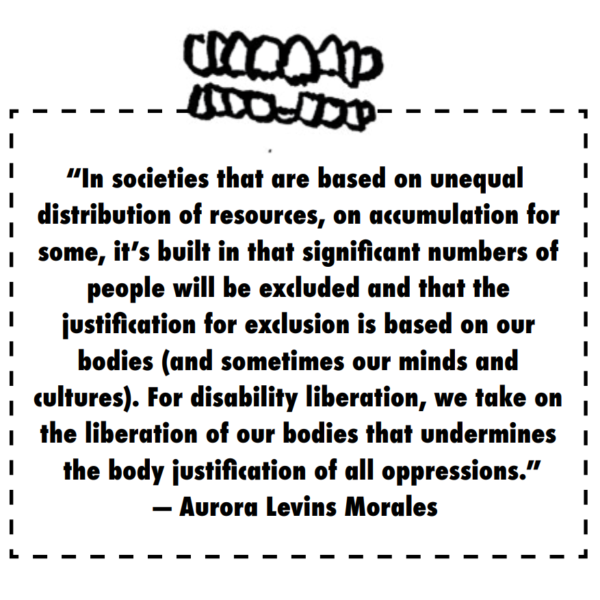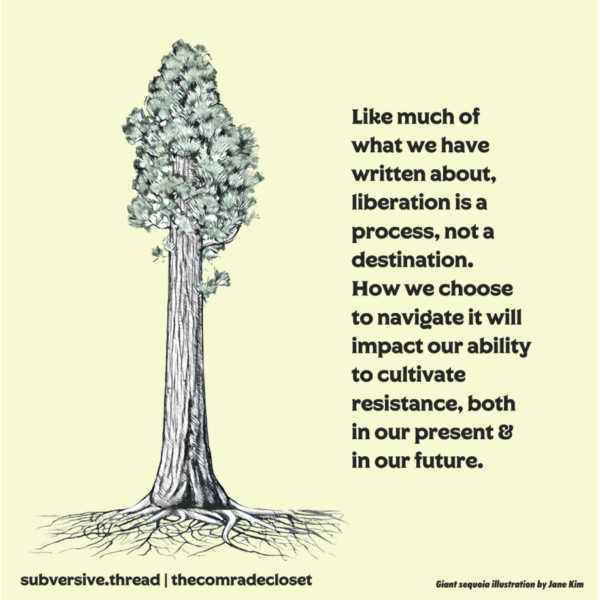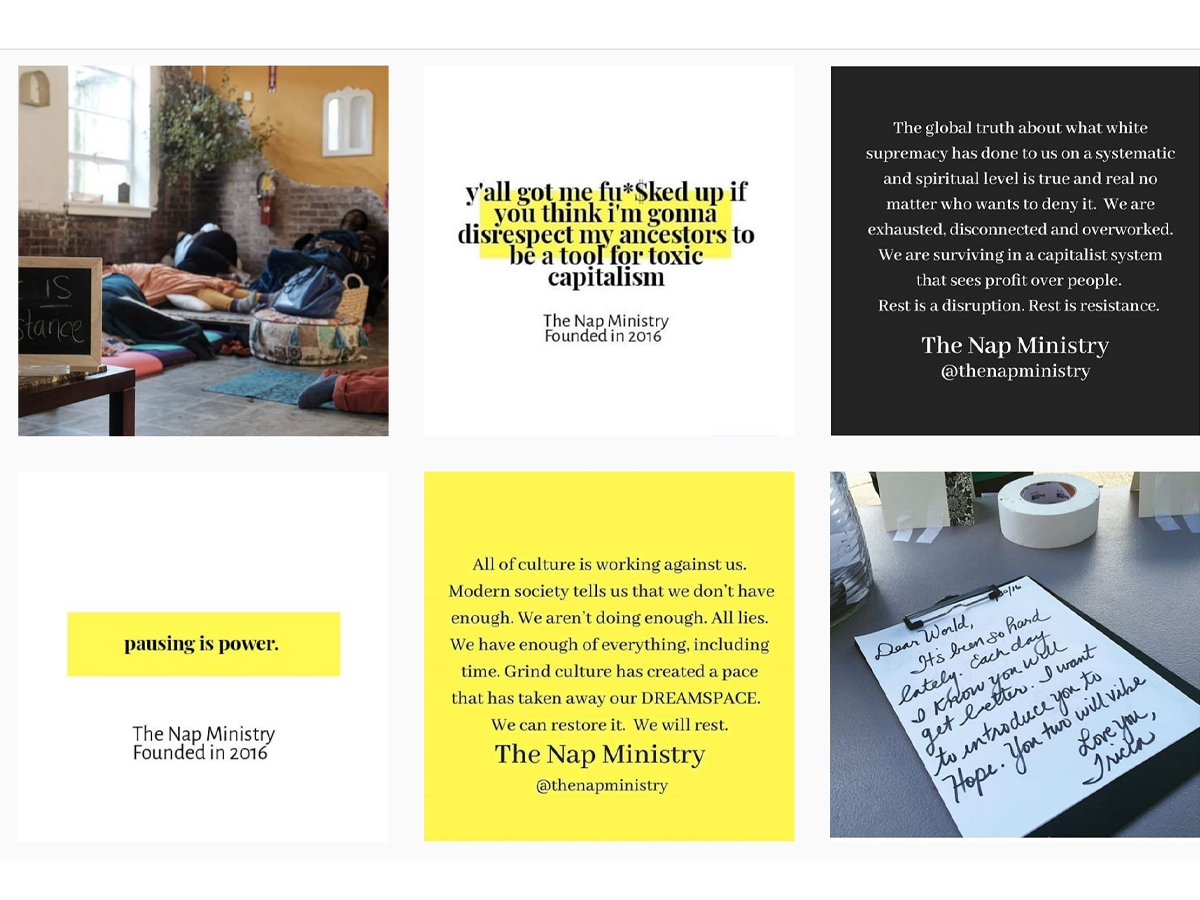by Michelle Ermolenko
From guerilla films to film as a keeper of memory, third cinema has always adapted itself to become a meeting ground for conversations to occur. Community building and sharing resources have always been a staple of disability justice – a means of breaking down barriers and creating conversations not only as a record of collective memory, but to give a voice to a community that has been historically silenced. Disability justice, along with the concept of mutual aid, provides a blueprint of relying on one another by documenting and creating a preservation of history/existence through the relationships that we build as a form of memory keeping. Teshome Gabriel writes: “Because the promise of freedom and the recovery of autonomy of identity lingers in memory, folklore offers an emancipatory ‘horizon’ – a liberated and alternative future. In a world where ‘logic’ and ‘reason’ are increasingly being used for ‘irrational’ purposes and alms, folklore attempts to conserve what official histories insist on erasing.” — in this sense, disability justice, along with the theory of crip time, allows for the disabled community to come together through community building and sharing resources in order to create a new collective memory – one where we survive in a world that wants us dead.
Radical self love and community building are part of the core concepts in disability justice thought and practice. For disabled and chronically ill creatives, we operate in ways that are inherently rebellious in the ableist and capitalist driven framework which we are forced to live in. Creating access to relationships, resources, and community support networks are parts of how the disabled community survives – relying on each other in solidarity, not charity through acts of mutual aid. The concept of “crip time” – where time and the ability to perform tasks that are usually based on capitalist/ableist standards – is reworked in order to focus on the needs of disabled folks, creates a foundation for disrupting oppressive systems of power by reclaiming time as a tool of collective memory and thought. Ellen Samuels writes that “Crip time is time travel. Disability and illness have the power to extract us from linear, progressive time with its normative life stages and cast us into a wormhole of backward and forward acceleration, jerky stops and starts, tedious intervals and abrupt endings.” Third cinema is seen as the cinema of resistance – as a means of creating a conduit for discussion and community through shared space, conversation, and rebellion against systems of power – in this sense, disability justice, crip time, and mutual aid networks create a space for conversations to occur. Pandemics, much like any other world-altering event, expose the weakness of power systems that are currently in place. As we collectively lose access to physical spaces of community building, we turn to the internet to act as our communal stage, where time becomes more fluid.
In a time where everyone is effectively forced to operate in crip time – despite our brains being plugged into existing in constant productivity in order to maintain a sense of “normalcy” – caring for one another is the only way we can survive. By cripping time (focusing on what our minds and bodies need in order to get through the day) – we start to beat the system internally, acting as a conduit for conversations to happen by taking back space and allowing for collaborative care to occur. Utilizing performance, video/film projects, and social media, collaborative online spaces are created by and with disabled creatives, contributing to a living history by documenting, examining, and sharing the relationships between crip time, mutual aid, and the world through these online spaces. Over the recent years, as online activism has increased and evolved, conversations and exchanging thoughts taking center stage when it comes to breaking down systems of oppression and allowing marginalized voices to be heard – through a culture that mixes DIY strategies for community building, collaborative projects, and resource sharing, the focus becomes not just on surviving in a capitalistic system, but to create safety networks and communities that allow the exchange of information to happen.
Mutual Aid As Community Building
Navigating a wide directory of volunteer-made networks, MutualAidHub allows for users to locate local mutual aid networks via an interactive map as well as providing the tools and resources for starting up a local mutual aid network. By offering access to introductory information on what mutual aid is, and giving users the necessary tools to learn and expand on the concept, MutualAidHub acts as a one stop shop in breaking down big concepts into manageable chunks of information. Resources ranging from food supply distribution to setting up neighborhood pods – a concept coined by Mia Mingus and BARC (Bay Area Transformative Justice Collective) are just a part of the wider, long term goals of breaking down barriers of access and allowing for mutual aid organizing to happen. In a nutshell, pods are microcosms of a larger “community” – it’s easier to break down and shift pods into what sort of things you need – clusters of folks who can buddy-up and split up the work of what a larger “community” may need, whether it’s skills training, access to food, or other needs and demands. While disability justice emphasizes mutual aid, most of the time we’re already practicing it without realizing it – it can be anything from a stranger on the internet paying for your dinner, or being the person someone can go to for their worries and vice versa. Mutual aid exists as building solidarity with one another – creating support systems and putting structures in place that otherwise we wouldn’t be allowed access to. Tools are a part of survival, as Russian revolutionary writer Peter Kropotkin wrote — “Practicing mutual aid is the surest means for giving each other and to all the greatest safety, the best guarantee of existence.” — in doing so, we start to break down the barriers and converse with one another through the networks we create, even in times of a pandemic.
In a similar vein, DisabilityVisibilityProject allows for disabled folks to share their thoughts through media creation, blog posts, and to engage in conversations around visibility and representation of disabled folks in media. It is one part blog, one part gateway to jobs and creating a community experience, with workshops and discussion events serving as a means to bridge together individuals and create access to information and platforms of knowledge and visibility. Similarly, #FilmDis is a monthly discussion held on twitter with regards to representation of disability in the media, bridging together disabled voices by allowing for a roundtable discussion to occur while sharing information through social media platforms, and creating discussions on a larger scale that would be unnoticed by the complacent audience who don’t question what they consume in the vast landscape of our media culture. By engaging in online conversation, a shift is created – by allowing for these discussions to take place, we can start to break down the larger conversations that happen when mainstream media refuse to acknowledge the disabled community in the media landscape.
The Nap Ministry focuses their work as a collective through community space and performance based initiatives. As we break through the boundaries of time, by embracing crip time we are “listening to the broken languages of our bodies, translating them, honoring their words.”(Samuels) The Nap Ministry’s usage of social media acts as the documentation for the work that they are doing to create crip time through performance and conversation, as the means to physically meeting cannot occur during this time. Operating as a conduit of disability justice, The Nap Ministry directly channels the thoughts of disability justice through the usage of performance – effectively embodying the idea of “(disability justice) challenges the idea that our worth as individuals has to do with our ability to perform as productive members of society. It insists that our worth is inherent and tied to the liberation of all beings. Like transformative justice, reproductive justice and environmental justice, it implies a movement-building strategy and an anti-capitalist critique.” (Lamm). Facilitating not only online workshops but also sharing resources through their blog and social media channels, The Nap Ministry creates a conversation while building an online community while repeatedly reminding us what disability justice is about – listening to not only the needs of our community but also to our bodies, and to accept that we all engage in disability justice in different measures and time, but that there is always a place at the table for everyone.
In Solidarity – Examining our relationships to our networks of care
Carolyn Lazard’s Get Well Soon examines the relationship between our bodies and time through the usage of visual imagery as well as captions – acting as a snapshot of sensory experience, Get Well Soon utilizes the notion of a video game as a guiding mechanism for examining the relationship between the subject and the world that they are existing in. The usage of captioning becomes a part of the work itself, making a conversation occur not only between the work and the viewer, but also within the reality of the piece itself. Time becomes a part of reality, but it is also used to warp and distort the passage of time, with pain and the body itself being depicted as conduits for the distortion of reality through the usage of visual and sound. Lazard’s work embodies third cinema with the notion of conversation between the viewer and the work itself – using sounds that cause discomfort to mimic the sensory experience of pain that the subject is feeling within their body and transferring that to the viewer through sound. Highlighting the frustrations of a medical system that does not give adequate support to the very same individuals that rely on it, Lazard examines not only the physical and emotional toll that chronic illness takes on an individual, but also the networks (or lack thereof) that capitalism puts on disabled folks in order to survive. The conversation that occurs in this piece bridges together the notion of what Bridging together the networks we create through mutual aid and care, and the toll that our systems of oppression take on us, leads to a conversation between Get Well Soon and the viewer, as we are asked questions on how to navigate a world that wants us dead and the networks we create to continue to survive.

The conversations we have not only as viewers but as participants in understanding the relationships we create as a part of community building is examined in Tina Takemoto’s Arm’s Length. Created as part of an ongoing collaborative project between herself and Angela Ellsworth, Arm’s Length examines Takemoto’s reaction to replicating the physical changes that Ellsworth was experiencing during her chemotherapy treatment over the course of many months, as a form of conversation between the two at a time where they were physically far apart. Takamoto would receive photos from Ellsworth during her treatment, and would restage the photographs using her body and everyday products as a means of “rhyming” the images that Ellsworth sent to her. Throughout the project, the focus became not just on documenting illness, trauma and relationships, but also as a means of working through navigating a relationship built on mutual aid. Arm’s Length is visceral not only in its imagery, but also how it examines the effect of acting as each other’s support systems has on both participants. In an interview with Strange Bedfellows, Ellsworth states: “ Our collaboration was a key support system in my experience inside and outside a “sick” world…Tina encouraged an artistic exchange around illness that was “a project.” Seeing what I was going through as a “project” positioned me in a place I understood. I didn’t have a solo practice during my illness. My energy was put into and kept up by the collaboration with Tina.” Arms Length works as a call/response to Imag(in)ed Malady as a whole, with the “visual images” acting as documentation, while Arm’s Length echoes Tina’s response to Angela leaving the country for a certain period of time after finishing treatment, a means of processing emotions as Tina states “ Thinking back, perhaps it makes sense that I had an emotional breakdown while we were out of touch. All my fear and anxiety over Angela’s illness and the possibility of losing her was always present and driving the work, but never could be openly acknowledged. Angela’s health and her physical distance gave me a space to experience the gravity of these emotions.” Through collaboration, there exists a framework of analyzing our place not only within the networks that we create, but how the systems we are submerged in can be dismantled by reflecting upon our roles in them.

Originally shot on super-8 film, David Wojnarowicz’s A Fire In My Belly conveys the relationship between the moving body, themes of reality and the changing landscape between ourselves and the growing vice-like grip that capitalism has on erasing and extinguishing autonomous thought in allowing for the survival of those who do not fit into the popular confines of what is deemed as “acceptable”. A Fire In My Belly not only examines the relationship of the body as a spectacle but also the growing destruction that occurs when the body is pulled into the system of capitalism, and forced to break down because it exists in a system that does not allow for support to exist. As it is an unfinished work, it is transformed from its original existence as a silent project created from 25 reels of super-8 film, existing as a vehicle to showcase the crash course disaster that assaults our minds and bodies through capitalism, making us fight off not just a sensory overload with its quick editing and visual onslaught, but revealing how exploitative and complicit we are in allowing for oppressive systems to flourish without doing anything about it. As Wojnarowicz notes in “In The Shadow of the American Dream: Soon All of This Will Be Picturesque Ruins”: “Owning a vehicle, you could drive by and with the pressure of your foot on the accelerator and with your eyes on the road you could pass it quickly–maybe not fast enough to overlook it completely, but fast enough so that the speed of the auto and the fear centers of the brain created a fractured marriage of light and sound. The images of poverty would lift and float and recede quickly like the gray shades of memory so that these images were in the past before you came upon them. It was the physical equivalent of the evening news.” — Wojnarowicz’s work examines the role that we as an audience have in our larger society – how we are part of the locomotive that will send us all crashing into disaster if we do not examine ourselves, our neighbors, and how we care for one another. Mutual aid serves as a guiding key towards liberation and breaking away from systems of oppression – without caring for one another and voicing our needs for access and conversation, we run the risk of running back into the trap of being a unquestionable audience, taking in images without questioning what they stand for – we run the risk of silencing ourselves when we turn away from each other, and letting the spirit of Third Cinema die out.
Works Cited/Further Reading/Viewings:
- “Disability Visibility Project.” Disability Visibility Project, https://disabilityvisibilityproject.com/.
- “Growing Deeper Roots in Mutual Aid: a List of Reflections, Inspiration, & Resources.” Mutual Aid Disaster Relief, 24 Apr. 2020, org/growing-deeper-roots-in-mutual-aid-a-list-of-reflections-inspiration-resources/.
- Lamm, Nomy. “This Is Disability Justice.” The Body Is Not An Apology, 1 Sept. 2015, https://www.thebodyisnotanapology.com/magazine/this-is-disability-justice/
- Lazard, Carolyn. “Get Well Soon.” Vimeo, 2015, https://vimeo.com/115058272.
- Lebrecht, James and Nicle Newnham, directors. Crip Camp: A Disability Revolution. Netflix, https://www.netflix.com/title/81001496.
- Samuels, Ellen. “Six Ways of Looking at Crip Time.” Disability Studies Quarterly, dsq-sds.org/article/view/5824/4684.
- Skin, Tooth, and Bone: the Basis of Movement Is Our People: a Disability Justice Primer. Sins Invalid, 2019.
- Dean Spade; Solidarity Not Charity: Mutual Aid for Mobilization and Survival. Social Text 1 March 2020; 38(1 (142)): 131-151. Doi: https://doi.org/10.1215/016424727971139
- “The Nap Ministry.” The Nap Ministry, 19 Apr. 2020, https://thenapministry.wordpress.com/.
- “Third Cinema as Guardian of Popular Memory: Towards a Third Aesthetics.” Teshome Gabriel, http://teshomegabriel.net/third-cinema-as-guardian-of-popular-memory
- “Pods and Pod Mapping Worksheet.” Bay Area Transformative Justice Collective, 4 Sept. 2016, https://batjc.wordpress.com/pods-and-pod-mapping-worksheet/
- “Sharing Disability Arts & Culture.” Disability Arts Online, 6 May 2020, https://disabilityarts.online/.
- “Her/She Senses: a Curator’s Interview with Angela Ellsworth & Tina Takemoto.” Strangebedfellowsexhibition, 31 May 2013, wordpress.com/2013/05/31/hershe-senses-a-curators-interview-with-angela-ellsworth-tina-takemoto/.
- Takamoto, Tina. Arm’s Length (1998) http://www.ttakemoto.com/armslength/video/armslength_lg.html
- Takamoto, Tina. Imagined Malady. (1997) http://www.ttakemoto.com/hershesenses/video/hershe_lg.html
- Wojnarowicz, David, A Fire In My Belly. The Fales Library and Special Collections at NYU, https://www.youtube.com/watch?v=t0QW0tYM4m0



